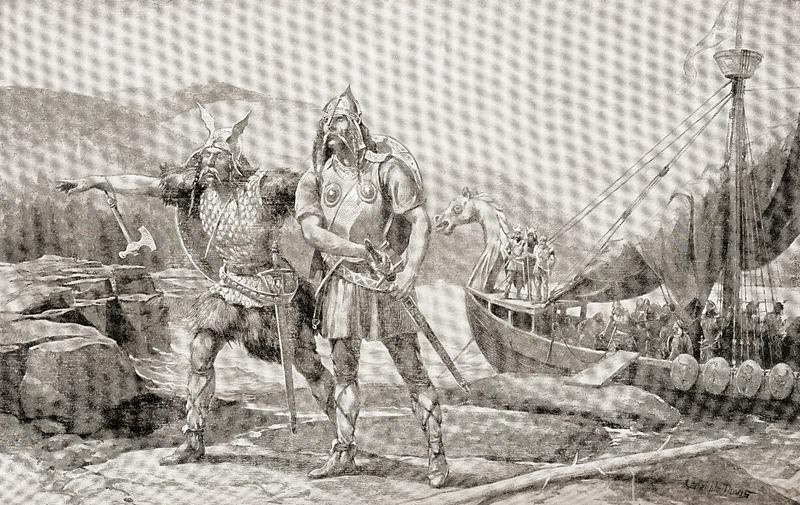Who Were The Vikings?
By | January 31, 2019

Throughout history, Vikings have been characterized as a barbaric breed. They hailed from Scandinavia and traveled the Norwegian and Baltic Seas for the purpose of trading. Vikings were known to be pirates, often raiding other ships and conquering villages and settlements throughout parts of Europe. Along the way, they were said to have imposed their domination and pillaged Anglo-Saxon, Celtic and Slavic settlements at random.

Vikings traded goods including furs, tusks, seal fat, used for boat sealant and medicinal salves.
Vikings are typically lumped into the category of “Scandinavian seafaring pirates and traders that raided and settled in many parts of Northwestern Europe in the eighth-eleventh centuries.” The earliest recorded Viking raids began in the '790s. They had a vast influence in Northern Europe and took advantage of their power.
The period of the '790s until 1066 is considered to be the Viking Age; roughly the eighth-eleventh centuries.

During that period in history, there were no cameras to document what the Vikings looked like. The image of what they “must” have looked like has been conjured up based on the archaeological findings over the years. Many modern concepts of the Vikings were derived from the more modern descendants of modern Scandinavia. This, however, often conflicts with the image that began to develop during the eighteenth century.
Vikings are historically characterized as barbaric creatures.
Modern conceptions of the Vikings have typically portrayed ferocious monsters who were uncivilized. While there has been evidence of violent behavior, much of what we believe about this ancient breed is likely cultural myths. With no living person in recent history ever being around to witness the Vikings and some of these perceived actions, much is left to speculation and are not necessarily accurate. Below are some other Viking facts that may surprise you.
There has never been a Viking helmet discovered with horns.

There is no concrete evidence that the Vikings ever wore horned helmets. The only confirmed Viking helmets ever found did not have any horns.

Vikings were thought to have impeccable hygiene.
Vikings have always been portrayed in literature as being rough and tumble, if not filthy. The truth, however, is that excavations of known Viking sites have uncovered grooming instruments including tweezers, razors, combs and ear cleaners fashioned out of animal bone. They were also known to fancy natural hot springs for bathing.
Vikings made it possible to generate fire and take it with them to sea.
In order to start fires for cooking and other uses, the Vikings would boil tree fungus (touchwood) in their own urine for days. What was left after the boiling was pounded into a material that resembled felt. The felt-like material contained sodium nitrate from the urine that would smolder rather than burn. This allowed them to take “fire” with them on the sea.
Vikings buried their deceased warriors in boats.
Vikings spent much of their time in boats on the sea traveling from place to place. That being the case, they found it fitting to bury their dead in boats. The Vikings believed that after death, courageous warriors would pass on to a magnificent new world. In order to help the deceased get where they were going, the Vikings would lay them to rest in boats and surround them with weapons, valuables and often sacrificed slaves.

Vikings were known to trade slaves in addition to the goods they peddled.
One of the most profitable commodities for the Vikings was the slaves they traded. They were known to enslave women and young men after pillaging settlements. The slaves were called “thralls” and were sold across Europe and the Middle East.
Vikings offered up their daughters for marriage as young as 12 years old.
Viking girls were married as young as 12 years old. Their job was to take care of the household while their husbands went on their trading excursions. Although they didn’t enjoy all the same rights and privileges the men did, they were able to inherit property and also request a divorce.
Viking men spent a lot of their time farming.
Farming was a necessary way of life for the Vikings. They did spend a lot of time on the seas, however, they also spent a lot of time on dry land. The vast majority of Vikings were peaceful and farmed to provide for their families. They planted barley, rye, and oats as well as raising cattle, goats, pigs, and sheep.

Vikings were known to ski.
During the Viking Age, Vikings found that skiing was a very efficient way to get around. Not only was it practical but they enjoyed it and skied for recreation. Ullr was the name of a god of skiing that the Vikings worshiped.
Viking men were known to bleach their hair blond.
Even as far back as the Viking Age, people desired to be blond. Men would use a soap with a high lye content to bleach their hair blond. Often, they would also bleach their beards. The lye soap served another purpose… it got rid of lice.
Vikings were not a unified group.
Contrary to popular belief, Vikings were not necessarily banded together for a common cause. In fact, this demographic most likely didn’t call themselves Vikings nor would they recognize each other as Vikings. The term, Viking, merely referred to all Scandinavians who went on overseas trading expeditions.

